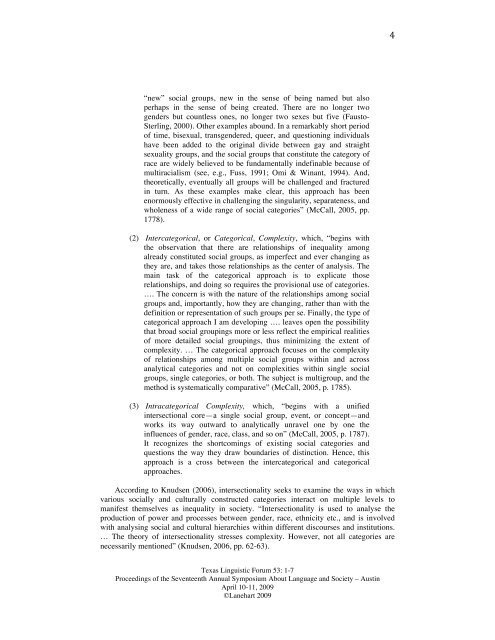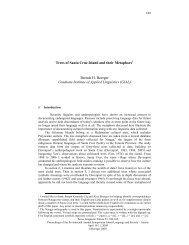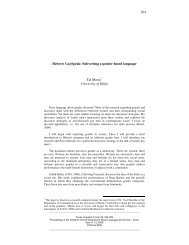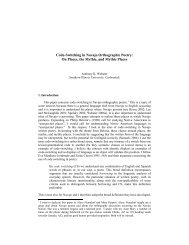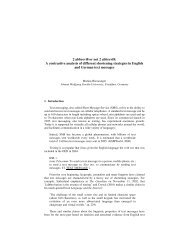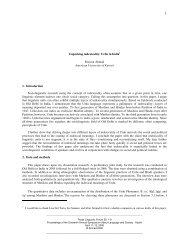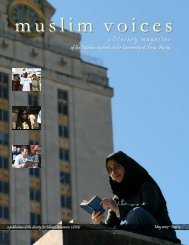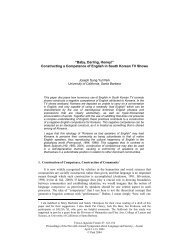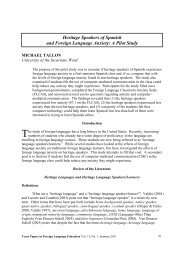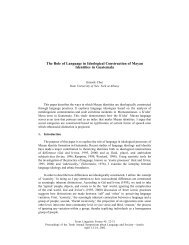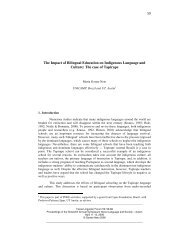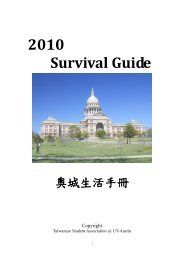Diversity and Intersectionality Sonja L. Lanehart University of Texas ...
Diversity and Intersectionality Sonja L. Lanehart University of Texas ...
Diversity and Intersectionality Sonja L. Lanehart University of Texas ...
Create successful ePaper yourself
Turn your PDF publications into a flip-book with our unique Google optimized e-Paper software.
<br />
<br />
“new” social groups, new in the sense <strong>of</strong> being named but also<br />
perhaps in the sense <strong>of</strong> being created. There are no longer two<br />
genders but countless ones, no longer two sexes but five (Fausto-<br />
Sterling, 2000). Other examples abound. In a remarkably short period<br />
<strong>of</strong> time, bisexual, transgendered, queer, <strong>and</strong> questioning individuals<br />
have been added to the original divide between gay <strong>and</strong> straight<br />
sexuality groups, <strong>and</strong> the social groups that constitute the category <strong>of</strong><br />
race are widely believed to be fundamentally indefinable because <strong>of</strong><br />
multiracialism (see, e.g., Fuss, 1991; Omi & Winant, 1994). And,<br />
theoretically, eventually all groups will be challenged <strong>and</strong> fractured<br />
in turn. As these examples make clear, this approach has been<br />
enormously effective in challenging the singularity, separateness, <strong>and</strong><br />
wholeness <strong>of</strong> a wide range <strong>of</strong> social categories” (McCall, 2005, pp.<br />
1778).<br />
(2) Intercategorical, or Categorical, Complexity, which, “begins with<br />
the observation that there are relationships <strong>of</strong> inequality among<br />
already constituted social groups, as imperfect <strong>and</strong> ever changing as<br />
they are, <strong>and</strong> takes those relationships as the center <strong>of</strong> analysis. The<br />
main task <strong>of</strong> the categorical approach is to explicate those<br />
relationships, <strong>and</strong> doing so requires the provisional use <strong>of</strong> categories.<br />
…. The concern is with the nature <strong>of</strong> the relationships among social<br />
groups <strong>and</strong>, importantly, how they are changing, rather than with the<br />
definition or representation <strong>of</strong> such groups per se. Finally, the type <strong>of</strong><br />
categorical approach I am developing …. leaves open the possibility<br />
that broad social groupings more or less reflect the empirical realities<br />
<strong>of</strong> more detailed social groupings, thus minimizing the extent <strong>of</strong><br />
complexity. … The categorical approach focuses on the complexity<br />
<strong>of</strong> relationships among multiple social groups within <strong>and</strong> across<br />
analytical categories <strong>and</strong> not on complexities within single social<br />
groups, single categories, or both. The subject is multigroup, <strong>and</strong> the<br />
method is systematically comparative” (McCall, 2005, p. 1785).<br />
(3) Intracategorical Complexity, which, “begins with a unified<br />
intersectional core—a single social group, event, or concept—<strong>and</strong><br />
works its way outward to analytically unravel one by one the<br />
influences <strong>of</strong> gender, race, class, <strong>and</strong> so on” (McCall, 2005, p. 1787).<br />
It recognizes the shortcomings <strong>of</strong> existing social categories <strong>and</strong><br />
questions the way they draw boundaries <strong>of</strong> distinction. Hence, this<br />
approach is a cross between the intercategorical <strong>and</strong> categorical<br />
approaches.<br />
According to Knudsen (2006), intersectionality seeks to examine the ways in which<br />
various socially <strong>and</strong> culturally constructed categories interact on multiple levels to<br />
manifest themselves as inequality in society. “<strong>Intersectionality</strong> is used to analyse the<br />
production <strong>of</strong> power <strong>and</strong> processes between gender, race, ethnicity etc., <strong>and</strong> is involved<br />
with analysing social <strong>and</strong> cultural hierarchies within different discourses <strong>and</strong> institutions.<br />
… The theory <strong>of</strong> intersectionality stresses complexity. However, not all categories are<br />
necessarily mentioned” (Knudsen, 2006, pp. 62-63).<br />
<strong>Texas</strong> Linguistic Forum 53: 1-7<br />
Proceedings <strong>of</strong> the Seventeenth Annual Symposium About Language <strong>and</strong> Society – Austin<br />
April 10-11, 2009<br />
©<strong>Lanehart</strong> 2009<br />
4


